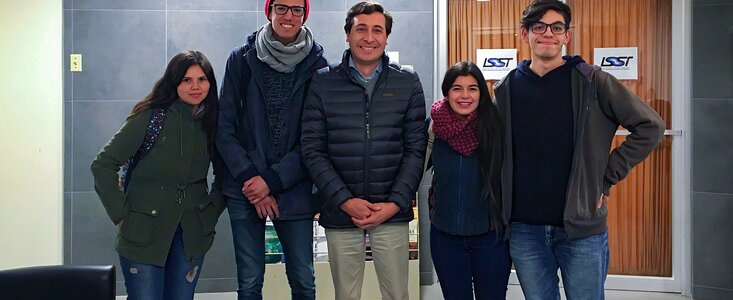NOAO: Commemorating 100 years of Einstein’s Theory of General Relativity
Team of University of La Serena students to recreate the Eddington Experiment that proved Einstein right
29 May 2019
On 2 July 2019 a total solar eclipse will sweep across the South Pacific Ocean before blocking out the Sun along a narrow swath of Chile and Argentina. This eclipse will pass directly over the National Science Foundation’s Cerro Tololo Inter-American Observatory (CTIO) in Chile. During the brief two-minute window of totality when the Moon completely covers the Sun, a team of astronomers from the National Optical Astronomy Observatory and students from the University of La Serena will be attempting to detect the minute deflection of starlight caused by the Sun’s gravitational field, and recreate an experiment originally done 100 years ago that made Albert Einstein a household name.
Albert Einstein published his General Theory of Relativity in 1915. One of his predictions was that very heavy objects with a lot of mass can bend space. Therefore, the gravity of the Sun would bend the light from stars behind it. Astronomer Arthur Eddington realized that this prediction could be tested during a total solar eclipse, when it is possible to view stars close to the Sun. If Einstein was right, stars that that appeared near an eclipsed Sun in the sky would seem deflected from their normal positions.
The solar eclipse on 29 May 1919 gave Eddington the opportunity to verify this prediction. To improve the chance of success, he assembled two teams to observe the eclipse — one in Africa and another one in South America. The combined data from these two locations confirmed the deflection of starlight and affirmed Einstein’s theory.
Juan Seguel (CTIO), Rob Sparks (NOAO) and four students from the University of La Serena, Gabriela Bustos, Sebastian Suarez, Javier Segura, and Ana León, will plan and execute the observations necessary to recreate the experiment from the summit of CTIO. The team will image the Sun and nearby stars during the solar eclipse on July 2 using an 11" Celestron Nexstar Telescope with a Hyperstar and a high-speed ZWO camera,. They will take calibration images before and after the eclipse as well as many images during the event to attempt to measure the very small predicted deflection of starlight.
Being able to reproduce the experiment that confirmed Einstein’s Theory of Relativity, a theory that greatly expanded our understanding of space, time, and mass, and to do it at an important astronomical research institution like CTIO, is very motivating. Recognizing that an opportunity to be involved in something like this is rare, Gabriela is looking forward to July 2, when she and her fellow students, “will find themselves in a place where science will be taking place and not only appreciating the eclipse as tourists.”
After the eclipse, the students, their professor, astronomer Dr. Guillermo Damke, and a larger group of students from the Observational Astronomy class will analyze the images. As Ana says, “it will be a great challenge to reconcile our studies at the university and the necessary preparation and planning for the precious day.” And Sebastian looks forward to using this opportunity to “apply everything we are learning as astronomy students and gain experience for the future.”
“We are working very fast to be able to get the necessary images with our equipment on July 2nd, and to measure the effect of gravity predicted by Einstein,” explained Seguel. The team is currently busy obtaining and testing the equipment necessary to replicate the Eddington Experiment and is writing scripts to control the telescope and camera during the brief time of totality.
“One of the challenges faced in this eclipse is that it occurs when the Sun is low in the sky; increased atmospheric distortion and turbulence from the low elevation will make the measurements substantially more challenging and may overwhelm the subtle deflection of starlight,” notes Sparks.
Seguel adds, “We are aware that the conditions are not ideal, but we believe that we should make the measurements commemorating the centennial of the experiment, and also prepare the group of Astronomy students in the technical details that involve this type of experience.”
Even if the measurement is unsuccessful this time, the team will get another chance on 14 December 2020 when another total solar eclipse will be visible from southern Chile. This eclipse will be much higher in the sky, yielding a better chance to make the challenging observations necessary to repeat this historic experiment.
Whatever the result of the experiment, Javier’s comment echoes that of everyone involved: “The 2019 eclipse will be a unique opportunity that cannot be missed!”
More information
NSF NOIRLab (National Optical-Infrared Astronomy Research Laboratory), the US center for ground-based optical-infrared astronomy, operates the international Gemini Observatory (a facility of NSF, NRC–Canada, ANID–Chile, MCTIC–Brazil, MINCyT–Argentina, and KASI–Republic of Korea), Kitt Peak National Observatory (KPNO), Cerro Tololo Inter-American Observatory (CTIO), the Community Science and Data Center (CSDC), and Vera C. Rubin Observatory (in cooperation with DOE’s SLAC National Accelerator Laboratory). It is managed by the Association of Universities for Research in Astronomy (AURA) under a cooperative agreement with NSF and is headquartered in Tucson, Arizona. The astronomical community is honored to have the opportunity to conduct astronomical research on Iolkam Du’ag (Kitt Peak) in Arizona, on Maunakea in Hawaiʻi, and on Cerro Tololo and Cerro Pachón in Chile. We recognize and acknowledge the very significant cultural role and reverence that these sites have to the Tohono O'odham Nation, to the Native Hawaiian community, and to the local communities in Chile, respectively.


